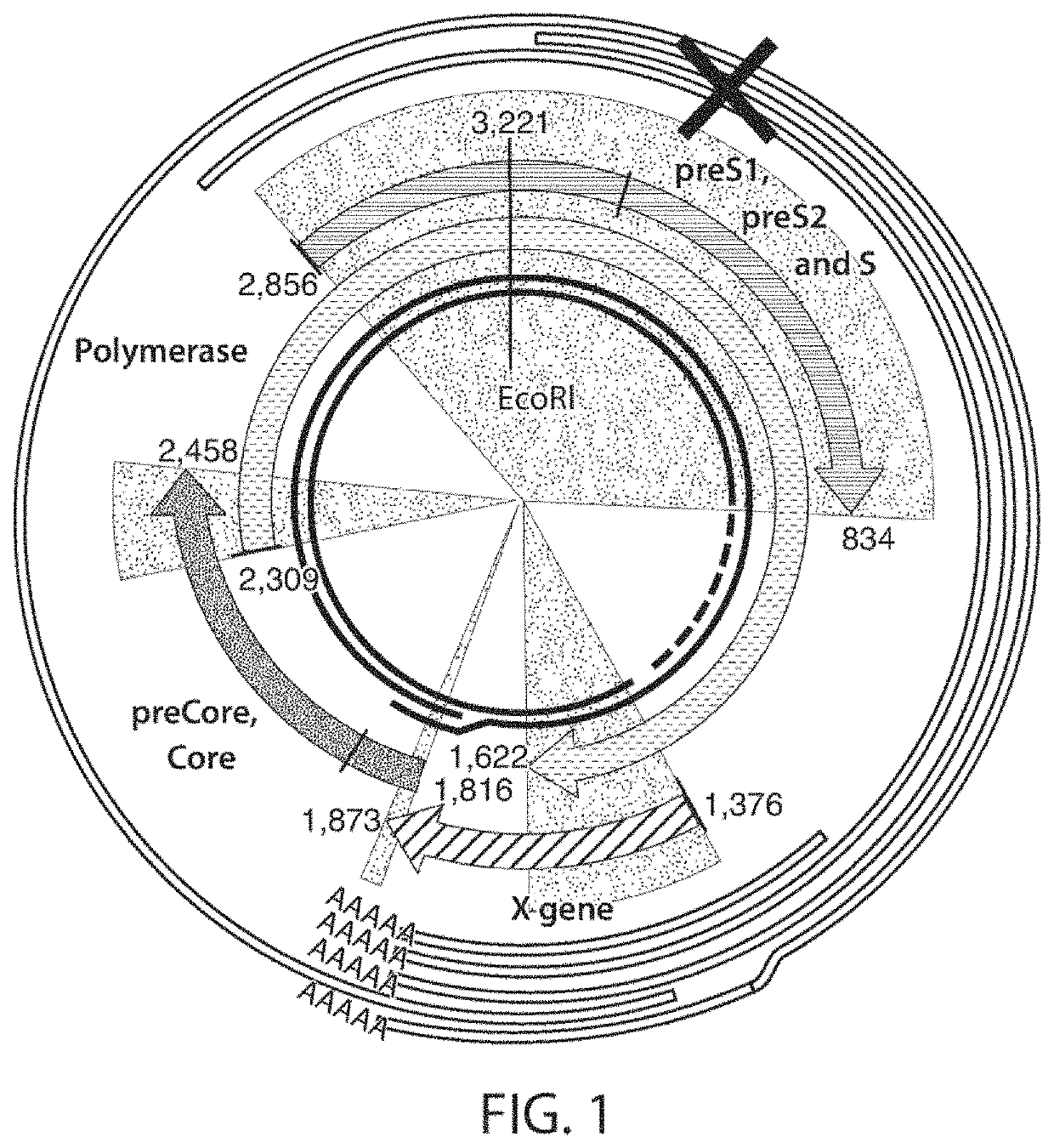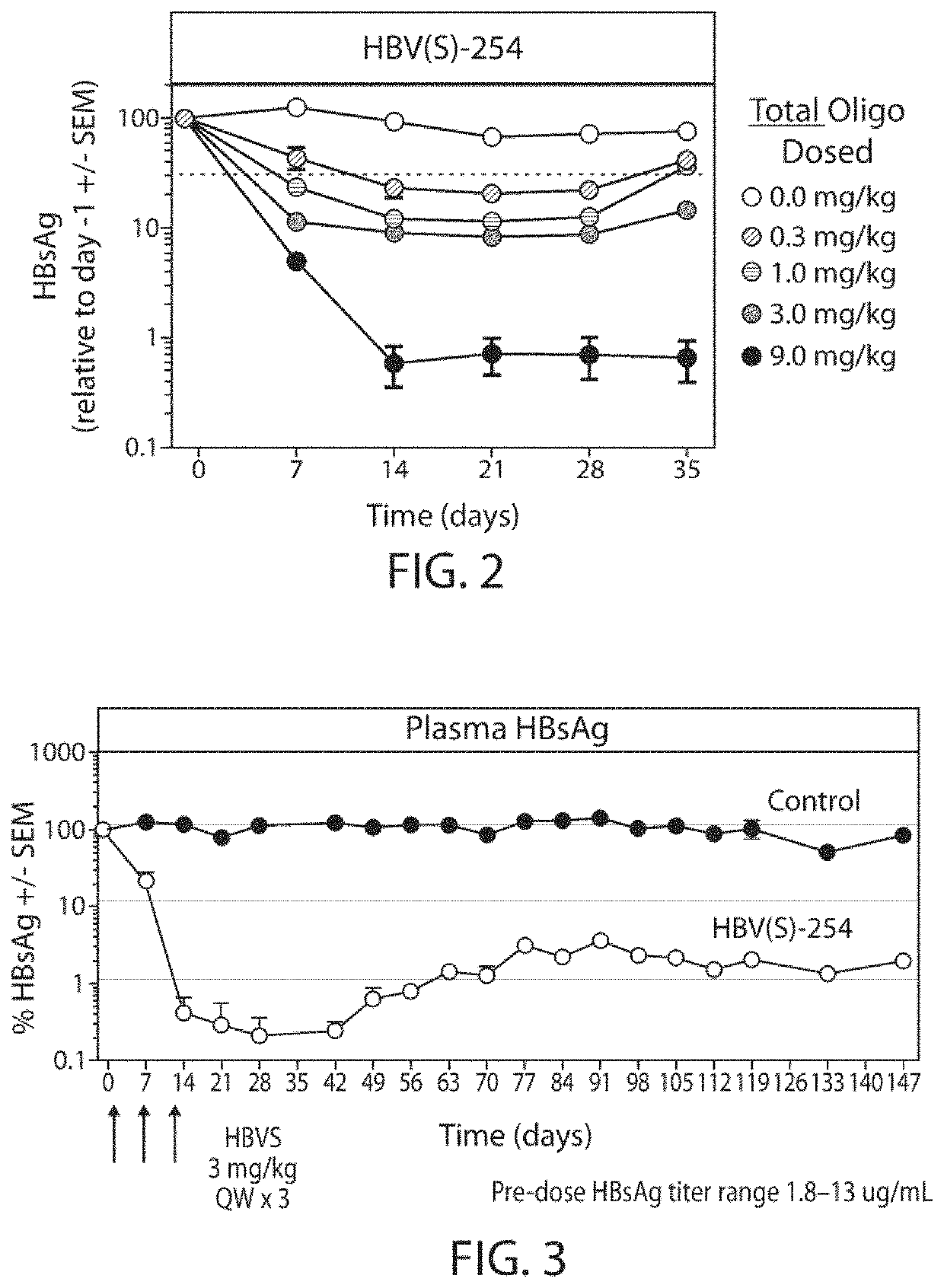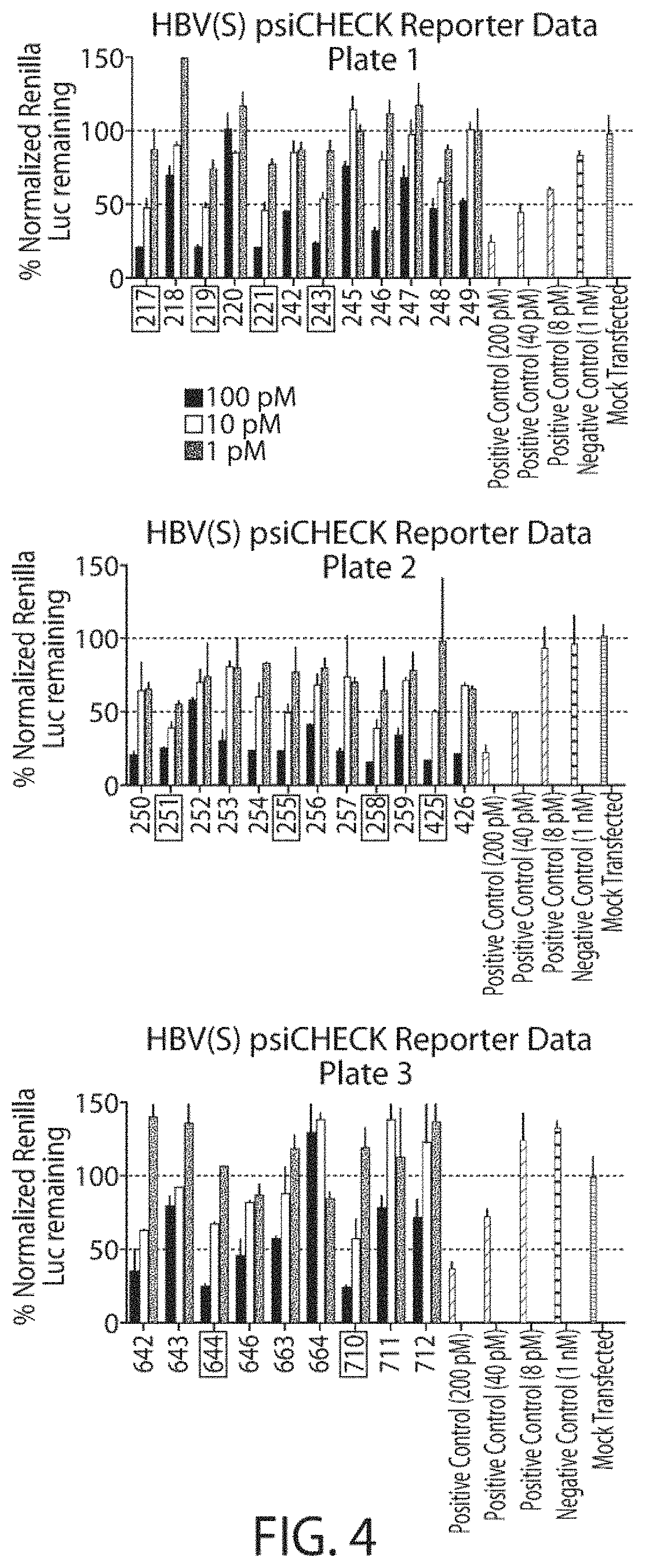Methods for treating hepatitis b infection
a technology of hepatitis b and hepatitis b, applied in the field of oligonucleotides, can solve the problems that the simultaneous targeting of hbv-x or both genes does not prevent the nuclear localization of hbcag, and achieves stable reduction of hbsag expression, improved oligonucleotide-based compositions, and high specificity.
- Summary
- Abstract
- Description
- Claims
- Application Information
AI Technical Summary
Benefits of technology
Problems solved by technology
Method used
Image
Examples
example 1
Development of Potent Oligonucleotide Inhibitors of HBsAg Expression
[0187]HBV surface antigen was identified as a target for RNAi-based therapy to treat HBV infection. As depicted in the HBV genome organization shown in FIG. 1, HBsAg is encoded by three RNA molecules transcribed from a single ORF. Oligonucleotides were designed for purposes of silencing one or more RNA transcripts that contribute to HBsAg assembly (example RNAi target site indicated by “X” in FIG. 1). An HBsAg-targeting oligonucleotide, HBV-254, was designed and evaluated in vitro and in vivo. HBV-254 was selected and designed based on an ability to directly target mRNA transcripts for four HBV RNA species. The HBV-254 duplex oligonucleotide used in the experiments included a sense strand of a sequence as set forth in (shown 5′ to 3′): GUGGUGGACUUCUCUCAAUAGCAGCCGAAAGGCUGC (SEQ ID NO: 21); and an antisense strand of a sequence as set forth in (shown 5′ to 3′): UAUUGAGAGAAGUCCACCACGG (SEQ ID NO: 22).
[0188]A single dos...
example 2
Sequence Conservation Analysis and Engineering Mismatches to Increase Global Therapeutic Utility
[0190]Several of the most potent oligonucleotides evaluated in Example 1 were compared against genome sequences for HBV genotypes A-I. The results of an initial conservation analysis are listed in Table 1. As shown, HBV-219 has relatively low percent conservation across these genomes. However, percent conservation increases significantly (from 66% to 96%) if a mismatch (MM) is introduced at position 15 of the guide strand. Genotyped hepatitis B virus (HBV) sequence data from the GenBank public database, incorporated herein by reference, was used for bioinformatics curation and alignment.
TABLE 1Initial conservation analysis with top HBV sequencesGuide Strand with MM% conservation% conservationOligonucleotidein boldacross genomesif MM is toleratedHBV-0217UUUGUGAGGAUUUUUGUCAAGG6697HBV-0219UUAUUGUGAGGAUUUUUGUCGG6696HBV-0254UCUGAGAGAAGUCCACCACGGG9498HBV-0255UACUGAGAGAAGUCCACCACGG9599HBV-0258UA...
example 3
Antiviral Activity of HBV(s)-219 Precursors
[0198]The effects of treatment with the HBV(s)-219 precursors on the subcellular localization of HBV core antigen (HBcAg) were evaluated. NODscid mice were subjected to a hydrodynamic injection (HDI) of a head-tail dimer of HBV genome. Treatment with the oligonucleotide was initiated 2 weeks post-HDI. Immunohistochemical staining of hepatocytes isolated from the mice following treatment showed a sharp reduction in HBV core antigen (HBcAg) expression.
[0199]RNA sequencing was performed to examine the effects of HBsAg knockdown on overall expression of HBV viral transcripts. Hepatocytes were isolated from HDI mice four days following three, once-weekly doses at 3mg / kg each. Total RNA was extracted from the hepatocytes and subjected to Illumina sequencing using the HiSeq Platform. FIG. 11B depicts RNA sequencing results in which detected RNA transcript sequences were mapped against the HBV RNAs. The target site of the HBV(s)-219 and its precurs...
PUM
| Property | Measurement | Unit |
|---|---|---|
| Fraction | aaaaa | aaaaa |
| Composition | aaaaa | aaaaa |
| Pharmaceutically acceptable | aaaaa | aaaaa |
Abstract
Description
Claims
Application Information
 Login to View More
Login to View More - R&D
- Intellectual Property
- Life Sciences
- Materials
- Tech Scout
- Unparalleled Data Quality
- Higher Quality Content
- 60% Fewer Hallucinations
Browse by: Latest US Patents, China's latest patents, Technical Efficacy Thesaurus, Application Domain, Technology Topic, Popular Technical Reports.
© 2025 PatSnap. All rights reserved.Legal|Privacy policy|Modern Slavery Act Transparency Statement|Sitemap|About US| Contact US: help@patsnap.com



